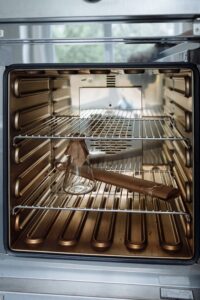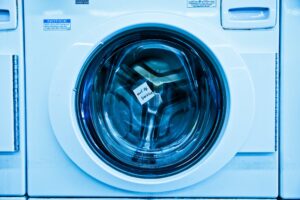Multimeters are essential tools in the field of appliance repair. They are versatile devices that can measure various electrical properties such as voltage, current, and resistance. A multimeter typically consists of a digital or analog display, a dial or buttons to select the desired measurement function, and probes to make contact with the electrical circuit being tested.
In appliance repair, multimeters play a crucial role in diagnosing and troubleshooting electrical issues. They help technicians identify faulty components, test continuity and resistance, and ensure the safety of both the appliance and the repair technician. Without a multimeter, it would be nearly impossible to accurately diagnose and fix electrical problems in appliances.
Key Takeaways
- Multimeters are essential tools for appliance repair technicians.
- They help diagnose electrical issues and identify faulty components in appliances.
- Accurate voltage readings are crucial for effective appliance repair.
- Multimeters also test continuity and resistance in appliances, ensuring safety for technicians.
- Digital multimeters offer advantages over analog models for appliance repair.
The Role of Multimeters in Diagnosing Electrical Issues in Appliances
One of the primary functions of a multimeter is to help identify electrical issues in appliances. By measuring voltage, current, and resistance, technicians can pinpoint the source of the problem and determine the appropriate course of action.
For example, if an appliance is not turning on, a multimeter can be used to measure the voltage at the power cord or outlet to determine if there is a problem with the power supply. If there is no voltage present, it could indicate a faulty power cord or a tripped circuit breaker. On the other hand, if there is voltage but the appliance still does not turn on, it could indicate a problem with the internal wiring or a faulty component.
Multimeters can also be used to diagnose issues such as short circuits or open circuits. By measuring continuity, technicians can determine if there is a complete path for electricity to flow through a circuit. If there is no continuity, it indicates an open circuit, which means there is a break in the wiring or a faulty component. Conversely, if there is continuity where there should not be, it indicates a short circuit, which means there is an unintended connection between two points in the circuit.
The Benefits of Using Multimeters for Appliance Repair
Using a multimeter in appliance repair offers several benefits that save time, money, and ensure accuracy.
Firstly, multimeters save time by quickly identifying the source of the problem. Instead of relying on trial and error or replacing multiple components, technicians can use a multimeter to pinpoint the exact issue. This allows for a more efficient repair process and reduces the time spent on unnecessary repairs.
Secondly, multimeters save money by preventing unnecessary component replacements. By accurately diagnosing the problem, technicians can avoid replacing parts that are still functioning properly. This not only saves money on replacement parts but also reduces the overall repair cost for the customer.
Lastly, multimeters provide accurate measurements, ensuring that the correct repairs are made. By accurately measuring voltage, current, and resistance, technicians can make informed decisions about which components need to be replaced or repaired. This accuracy leads to more effective repairs and reduces the likelihood of further issues down the line.
How Multimeters Help to Identify Faulty Components in Appliances
Multimeters are invaluable tools for identifying faulty components in appliances. By measuring voltage, current, and resistance at various points in the circuit, technicians can determine if a component is functioning properly or if it needs to be replaced.
For example, if an appliance is not heating up properly, a multimeter can be used to measure the resistance of the heating element. If the resistance is significantly higher or lower than the expected value, it indicates a faulty heating element that needs to be replaced.
Similarly, if an appliance is not cooling properly, a multimeter can be used to measure the current flowing through the compressor. If the current is too high or too low, it indicates a problem with the compressor that needs to be addressed.
By systematically testing each component with a multimeter, technicians can identify and replace faulty parts, ensuring that the appliance functions properly.
The Importance of Accurate Voltage Readings in Appliance Repair
Accurate voltage readings are crucial in appliance repair as they provide valuable information about the electrical system of the appliance. Voltage readings help technicians determine if the power supply is functioning properly and if there are any issues with the internal wiring or components.
For example, if an appliance is not turning on, measuring the voltage at the power cord or outlet can help determine if there is a problem with the power supply. If the voltage is significantly lower than expected, it could indicate a faulty power cord or a tripped circuit breaker. On the other hand, if the voltage is within the expected range, it suggests that the issue lies within the appliance itself.
Accurate voltage readings are also important when testing specific components. For instance, when testing a motor, technicians need to measure the voltage across its terminals to ensure that it is receiving the correct amount of power. If the voltage is too low, it could indicate a problem with the wiring or a faulty control board.
In summary, accurate voltage readings provide valuable insights into the electrical system of an appliance and help technicians diagnose and fix issues effectively.
The Role of Multimeters in Testing Continuity and Resistance in Appliances
Multimeters are essential for testing continuity and resistance in appliances. Continuity testing helps determine if there is a complete path for electricity to flow through a circuit, while resistance testing measures how much an object resists the flow of electric current.
Continuity testing is particularly useful when diagnosing open circuits or breaks in wiring. By measuring continuity between two points in a circuit, technicians can determine if there is an uninterrupted path for electricity to flow. If there is no continuity, it indicates an open circuit and helps identify where the break in wiring or faulty component is located.
Resistance testing, on the other hand, helps identify faulty components or objects that may be affecting the performance of an appliance. By measuring the resistance of a component, technicians can determine if it is within the expected range. If the resistance is too high or too low, it indicates a problem with the component that needs to be addressed.
For example, when testing a heating element in an oven, technicians can measure its resistance to ensure that it is within the expected range. If the resistance is significantly higher or lower than expected, it indicates a faulty heating element that needs to be replaced.
The Significance of Multimeters in Troubleshooting Appliance Problems
Multimeters play a significant role in troubleshooting appliance problems. They help technicians identify the root cause of the issue and determine the appropriate course of action.
For instance, if an appliance is not turning on, a multimeter can be used to measure the voltage at various points in the circuit to determine where the problem lies. If there is no voltage at the power cord or outlet, it suggests a problem with the power supply. On the other hand, if there is voltage but the appliance still does not turn on, it indicates a problem with the internal wiring or a faulty component.
Multimeters also help troubleshoot issues such as intermittent faults or inconsistent performance. By measuring voltage, current, and resistance at different times and under different conditions, technicians can identify patterns or inconsistencies that may be causing the problem.
For example, if an appliance works intermittently, technicians can use a multimeter to measure voltage and current at different points in the circuit while the appliance is both working and not working. This can help identify any fluctuations or abnormalities that may be causing the intermittent behavior.
In summary, multimeters are invaluable tools for troubleshooting appliance problems as they provide accurate measurements and help identify patterns or inconsistencies that may be causing the issue.
How Multimeters Help to Ensure the Safety of Appliance Repair Technicians
Safety is paramount in appliance repair, and multimeters play a crucial role in ensuring the safety of technicians. By providing accurate measurements and allowing technicians to test circuits and components without direct contact, multimeters help prevent accidents and injuries.
For example, when testing voltage, technicians can use a multimeter to measure the voltage at various points in the circuit without having to make direct contact with live wires. This reduces the risk of electric shock or electrocution.
Multimeters also help identify potentially hazardous situations such as short circuits or open circuits. By measuring continuity, technicians can determine if there is a complete path for electricity to flow through a circuit. If there is no continuity, it indicates an open circuit, which means there is a break in the wiring or a faulty component. This information helps technicians avoid potentially dangerous situations and take appropriate precautions.
In addition, multimeters often come with safety features such as overload protection and non-contact voltage detection. These features further enhance the safety of technicians by preventing damage to the multimeter and alerting them to the presence of live voltage without direct contact.
The Advantages of Using Digital Multimeters for Appliance Repair
Digital multimeters offer several advantages over analog multimeters in appliance repair.
Firstly, digital multimeters provide more accurate measurements. Analog multimeters rely on a needle or pointer to indicate the measurement, which can be subject to parallax error or misinterpretation. Digital multimeters, on the other hand, provide precise numerical readings on a digital display, eliminating any ambiguity or potential for error.
Secondly, digital multimeters offer a wider range of measurement functions and features. They often include additional functions such as capacitance measurement, temperature measurement, and frequency measurement, which can be useful in diagnosing and troubleshooting appliance problems.
Digital multimeters also tend to have better resolution and sensitivity compared to analog multimeters. This means they can detect smaller changes in voltage, current, or resistance, allowing for more precise measurements.
Lastly, digital multimeters are generally more user-friendly and easier to use. They often have intuitive interfaces, backlit displays for easy reading in low-light conditions, and auto-ranging capabilities that automatically select the appropriate measurement range. These features make digital multimeters more accessible to technicians of all skill levels.
In summary, digital multimeters offer greater accuracy, a wider range of measurement functions, and improved user-friendliness compared to analog multimeters, making them the preferred choice for appliance repair.
Why Multimeters are Essential Tools for Appliance Repair
Multimeters are essential tools in the field of appliance repair. They play a crucial role in diagnosing electrical issues, identifying faulty components, testing continuity and resistance, troubleshooting problems, and ensuring the safety of technicians.
By providing accurate measurements and allowing technicians to test circuits and components without direct contact, multimeters save time, money, and ensure the accuracy of repairs. They help technicians quickly identify the source of the problem, prevent unnecessary component replacements, and make informed decisions about which parts need to be repaired or replaced.
Digital multimeters offer several advantages over analog multimeters, including more accurate measurements, a wider range of measurement functions, and improved user-friendliness. Their precise numerical readings, additional features, and ease of use make them the preferred choice for appliance repair technicians.
In conclusion, multimeters are indispensable tools in appliance repair. They provide valuable insights into the electrical system of appliances, help diagnose and fix issues effectively, and ensure the safety of both the appliance and the repair technician. Without multimeters, appliance repair would be a much more challenging and less efficient process.
How Important is a Multimeter in Appliance Repair and Why should I Understand and Use it?
When it comes to appliance repair, using a multimeter for appliance troubleshooting is crucial. It helps in measuring electrical currents, voltage, and resistance, which are essential for diagnosing and fixing issues. Understanding how to use a multimeter can save time and money by accurately pinpointing the problem.
FAQs
What is a multimeter?
A multimeter is an electronic measuring instrument that can measure various electrical properties such as voltage, current, and resistance.
Why is a multimeter important in appliance repair?
A multimeter is important in appliance repair because it can help diagnose electrical problems in appliances. It can measure the voltage and current flowing through different components of an appliance, helping to identify faulty parts that need to be replaced.
What are some common electrical problems in appliances?
Some common electrical problems in appliances include faulty switches, damaged cords, blown fuses, and malfunctioning motors.
How do you use a multimeter in appliance repair?
To use a multimeter in appliance repair, you need to first identify the electrical component that you want to test. Then, you need to set the multimeter to the appropriate setting for the property you want to measure (e.g. voltage, current, resistance). Finally, you need to connect the multimeter to the component and read the measurement on the display.
Can a multimeter be used to repair all types of appliances?
A multimeter can be used to diagnose and repair most types of appliances that have electrical components. However, some appliances may require specialized tools or knowledge to repair, and in those cases, a multimeter may not be sufficient.



